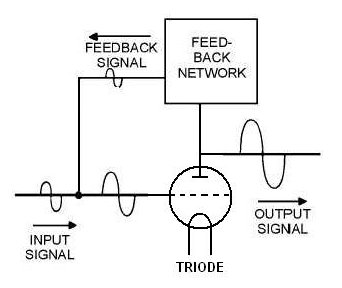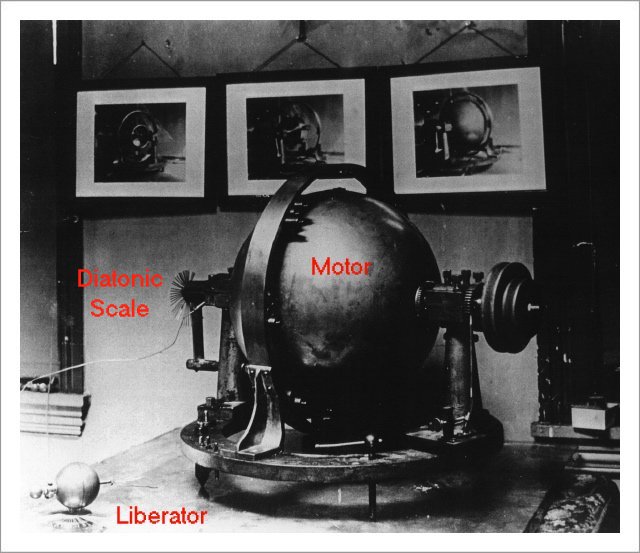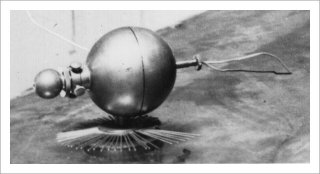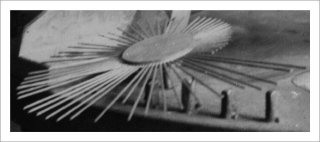







The Role of Acoustic Feedback in Keely's Machines
Acoustic feedback, as we understand it today, was an unknown phenomenon in Keely's time.
So, how does this subject get into the equation?
Looking at Keely's motors there is evidence that acoustic feedback was occurring in his devices and that he tried to deal with the problems created by it without ever completely understanding what he was up against.
In my view his failure to bring the phenomenon under control accounts for most, if not all, of the problems he encountered.
But before we lock at his machines let us briefly examine what feedback, especially regenerative feedback, is and how it applies here.
Acoustic feedback, also known as the Larsen effect, is the result of coupling a portion of the output signal back to the input of an amplifier.

We all have noticed the phenomenon when a microphone is placed too close to a loudspeaker by a musician and the whole system starts to howl in an ever increasing pitch and volume.
What happens is that some frequencies get reinforced by the added input, generating harmonics that were inaudible before to a level where they get also reinforced and so on, creating runaway frequencies that are impossible to control once they have started.
As undesirable as the phenomenon is in, say a concert hall, it has been used beneficially in radio receivers to amplify and enhance the input signal.
When radio first started it was the humble detector circuit complete with a galena crystal that enabled reception. The signal was weak. After Edison discovered that electrons flowed from a heated filament to a positively charged plate in an evacuated light bulb Dr. Lee deForest, successfully introduced a third element -the grid-between the filament and the plate, creating the triode. By feeding the received signal to the grid and applying a voltage between the filament and the plate the stronger flow could be controlled by the weak input signal (hence the word valve), which made it possible to amplify the incoming radio signal.
In 1913 the brilliant Edwin Howard Armstrong, while still a student, fed part of the output of the triode back into its input in an effort to improve radio reception. He called the process he called "regenerative feedback." It greatly amplified the signal and, if enough feedback was applied to the input, it also acted as an oscillator.

Keely did not use valves, they were not even on the horizon then, so how could he have struck acoustic feedback?
The clue lies in the construction of his motors.

His motor consists, as you can see in the photograph, of two devices, the liberator and the motor proper which are connected by a wire made from silver, gold and platinum. Both devices, as well as the wire were tuned to a specific frequency with almost unbelievable precision. In addition special resonators were mounted on the devices to ensure maximum resonance. These resonators he calls his diatonic scale. They are clearly visible here. Below are close ups of the liberator with the diatonic scale and the scale on its own.

 Now we have both, the equivalent of a microphone (liberator) connected a loudspeaker (motor). All we need is some additional energy feeding into the system and we have a closed feedback loop.
Keely claimed that his liberator provided that additional energy, after all that was the whole idea of the thing.
If the arrangement performs the way Keely claimed we have now a real feedback problem. The uncontrolled runaway frequencies created by this arrangement would account for Keely's inability to control the speed of his motor and the sudden reversals. From what I can make out his motors only ever ran for very short periods of time.
Keely was not unaware of the problem, though in my estimation never understood what he was up against and only partially controlled the phenomenon in a somewhat crude fashion.
In one explanation of the procedure required to get his motor to run he says:...........
The localization to the neutral centre is then established by dampening the steel rods, on the scale at the back, representing the thirds, sixths, and ninths, drawing a piece of small gum tube over them, which establishes harmony to the chord mass of the instrument. Concordance is thus effected between the disintegrator and the ninths of the scale at base of transmitters with telephonic head.
In my view dampening the resonators with gum tubing was his attemt to reduce the feedback without eliminating it, thereby gaining the advantage of further amplification and achieving enhanced amplitude for the higher frequencies.
Now we have both, the equivalent of a microphone (liberator) connected a loudspeaker (motor). All we need is some additional energy feeding into the system and we have a closed feedback loop.
Keely claimed that his liberator provided that additional energy, after all that was the whole idea of the thing.
If the arrangement performs the way Keely claimed we have now a real feedback problem. The uncontrolled runaway frequencies created by this arrangement would account for Keely's inability to control the speed of his motor and the sudden reversals. From what I can make out his motors only ever ran for very short periods of time.
Keely was not unaware of the problem, though in my estimation never understood what he was up against and only partially controlled the phenomenon in a somewhat crude fashion.
In one explanation of the procedure required to get his motor to run he says:...........
The localization to the neutral centre is then established by dampening the steel rods, on the scale at the back, representing the thirds, sixths, and ninths, drawing a piece of small gum tube over them, which establishes harmony to the chord mass of the instrument. Concordance is thus effected between the disintegrator and the ninths of the scale at base of transmitters with telephonic head.
In my view dampening the resonators with gum tubing was his attemt to reduce the feedback without eliminating it, thereby gaining the advantage of further amplification and achieving enhanced amplitude for the higher frequencies.
NOTE: For the amplification to occur the signal that is fed back into the circuit must be in phase with the incoming signal.That means that in Keely's arrangement the length of the wire or tube connecting the two devices is critical. Because the incoming signal travels along the waveguide there is a time delay before it reaches the motor. The feedback signal travels along the same waveguide in the opposite direction also incurring a time delay. The length of the wire or tube must be so calculated that the two signals are in phase at all times at the point of origin.
Next Chapter:
KEELY AND THEOSOPHY
Contact:
Hans von Lieven, copyright
2007



















